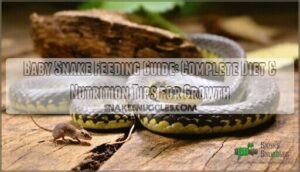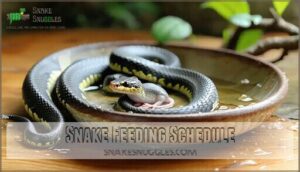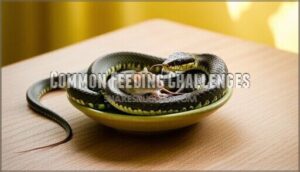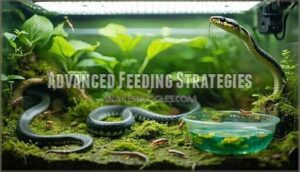This site is supported by our readers. We may earn a commission, at no cost to you, if you purchase through links.
 Feeding your baby snake properly requires understanding their specific needs and following safe practices.
Feeding your baby snake properly requires understanding their specific needs and following safe practices.
You’ll need to provide appropriately sized prey every 5-7 days, with frozen-thawed rodents being the safest option.
The prey should match the thickest part of your snake’s body, and you’ll want to monitor their weight gain closely.
Most baby snakes can go several days without eating after hatching while they absorb their yolk sac.
Getting the basics right from the start prevents feeding problems and guarantees healthy growth throughout your snake’s life.
Table Of Contents
- Key Takeaways
- Baby Snake Feeding Basics
- Snake Feeding Schedule
- Prey Size and Selection
- Feeding Techniques for Snakes
- Nutritional Needs of Snakes
- Growth Monitoring and Health
- Common Feeding Challenges
- Advanced Feeding Strategies
- Frequently Asked Questions (FAQs)
- How much should a baby snake eat?
- What can I feed my baby snake for the first time?
- How do I tell if my baby snake is hungry?
- How often should I feed my juvenile milk snake?
- Can baby snakes eat fruit or vegetables?
- How do I know if my snake is sick?
- What temperature should the feeding area be?
- Can different snake species live together safely?
- When should I take my baby snake to vet?
- Conclusion
Key Takeaways
- You’ll need to wait until your baby snake is about one month old before offering food, since they rely on their yolk sac for initial nutrition during their first weeks of life.
- Match prey size to your snake’s thickest body section – the prey shouldn’t be wider than your snake’s girth to prevent choking or regurgitation issues.
- Feed your baby snake every 5-7 days with frozen-thawed rodents like pinkie mice, which are safer than live prey and provide complete nutrition for healthy growth.
- Monitor your snake’s weight weekly using digital scales accurate to 0.1g – healthy hatchlings should gain 8-15% of their body weight each week during the first two months.
Baby Snake Feeding Basics
Feeding baby snakes properly sets the foundation for their lifelong health and growth.
You’ll need to understand their unique nutritional requirements, from relying on yolk sacs initially to switching to appropriately sized prey within their first month, which is crucial for their growth.
Initial Diet and Prey Types
Your newborn snake’s initial diet depends entirely on its species, but most hatchlings start with whole prey items.
Different species have vastly different appetites from day one.
Common initial prey for baby snakes:
- Earthworms and small insects for garter snakes
- Pinky mice for ball pythons and corn snakes
- Small fish and tadpoles for water snakes
- Crickets and slugs for smaller species
- Bird eggs for arboreal species
The key is matching food size to your snake’s mouth width for safe swallowing.
Yolk Sac Usage and Nutrition
Baby snakes come equipped with nature’s lunchbox—the yolk sac provides essential nutrients for up to a month after hatching.
Nature’s first meal plan comes pre-installed—no assembly required!
This nutrient uptake system supports snake development without immediate feeding pressure. Your newborn snake’s yolk sac nutrition handles initial feeding needs, allowing time to establish proper baby snake diet routines.
Snakelet nutrition depends entirely on this built-in system initially.
Feeding Guidelines and Techniques
When your newborn snake finishes absorbing its yolk sac, you’ll need proper feeding tools and techniques for successful captive care.
Use feeding tongs to present prey safely, create calm feeding environments, and watch for hunger cues like active searching behavior.
Your baby snake feeding guide should emphasize warming thawed prey to room temperature and establishing consistent snake feeding schedules using these proven feeding techniques, including proper feeding tools.
Snake Feeding Schedule
Getting your baby snake’s feeding schedule right is essential for healthy growth and development.
You’ll need to take into account your snake’s age, species, and size when establishing how often to feed and ensuring proper hydration.
Frequency of Feeding
Your snake’s baby snake feeding schedule depends on age and species.
Hatchlings typically eat every 5-7 days, while juveniles may stretch to 7-10 day feeding intervals.
Watch for hunger cue recognition like increased activity before meals.
Daily feed timing consistency reduces stress and establishes routine eating habits.
Proper meal frequency prevents overfeeding issues and supports healthy growth patterns.
Water Needs and Hydration
Proper hydration keeps your snake healthy and supports digestion.
You’ll need to provide a shallow dish of fresh water at all times to guarantee hydration and prevent dehydration signs.
Essential water requirements include:
- Water Quality – Change water weekly to prevent contamination and maintain clean drinking habits
- Hydration Methods – Monitor for dehydration signs like wrinkled skin or sunken eyes
- Humidity Levels – Maintain proper humidity around the water dish to support water intake
Feeding Frequency by Age
As your snake grows, feeding frequency changes dramatically.
Hatchlings need food every 3-5 days, while juveniles eat twice weekly.
Adults require feeding just once per week.
| Age Group | Feeding Schedule | Prey Size |
|---|---|---|
| Hatchling (0-3 months) | Every 3-5 days | Pinkie mice |
| Juvenile (3-12 months) | Twice weekly | Fuzzy mice |
| Adult (12+ months) | Once weekly | Adult mice |
Age-based diet adjustments guarantee proper snake growth and neonate nutrition development, ensuring a healthy diet is crucial for your snake’s overall well-being.
Prey Size and Selection
Choosing the right prey size makes the difference between a thriving baby snake and serious health problems.
You’ll need to match prey width to your snake’s thickest body section while considering species-specific dietary preferences that vary dramatically between different types of snakes.
Importance of Prey Size
Getting prey size right matters more than you might think.
Your wrong prey size choice could kill your baby snake—get this fundamental right first.
Your snake’s mouth should easily accommodate the prey width without straining. Measure prey against your snake’s girth at its thickest point for proper Prey Proportions.
Wrong Size Guidelines can cause choking or regurgitation. Feeding Safety depends on matching prey size to your newborn snake feeding needs perfectly.
Understanding the correct prey size chart is essential for the health and well-being of your snake.
Prey Types for Different Species
Different species have unique dietary preferences that you’ll need to match for successful feeding.
Each snake family has evolved specific feeding behaviors that determine their preferred prey types:
- Colubrids (corn snakes, king snakes): Pinky mice work for 95% of hatchlings, though some king snakes prefer lizard tails
- Pythons (ball pythons, carpet pythons): Pinky or fuzzy mice, with 80% accepting unscented prey readily
- Boas (boa constrictors, sand boas): Pinky mice or small rats, shifting to larger prey after first shed
- Elapids (cobras, coral snakes): Small lizards, fish, or pinky mice depending on wild diet preferences
- Vipers (rattlesnakes, bush vipers): Small mammals or amphibians with 94% acceptance rates in captivity
Understanding the correct prey size guidelines is vital for the health and well-being of your snake.
Common Prey Items for Baby Snakes
Regarding newborn snake food, you’ll find several reliable options that work well for most species.
Small mice like pinky rats and frozen thawed mice are popular choices, while insect prey such as cricket feed works for smaller species.
Some baby snakes prefer fish eggs or earthworms.
Proper prey selection depends on your snake’s size and natural diet preferences.
Feeding Techniques for Snakes
Proper feeding techniques help baby snakes move safely from their yolk sac nutrition to independent eating.
You’ll need the right tools and methods to encourage healthy feeding habits while avoiding common mistakes that can stress or harm your young snake, using the correct approach to support independent eating.
Using Feeding Tongs and Containers
You’ll need feeding tongs and containers to handle prey safely.
Feeding tongs prevent accidental bites during feeding sessions while keeping your hands away from your snake’s strike zone.
Use separate feeding containers to avoid habitat association with food, making your snake less aggressive in its main enclosure.
These feeding tools create controlled environments that reduce stress for both you and your pet.
Understanding proper snake feeding techniques is essential for a healthy and stress-free feeding experience, and using the right tools is crucial for a safe and healthy environment.
Scent-Rubbing Prey for Reluctant Feeders
When feeding tongs don’t work, scent transfer becomes your secret weapon.
Rub prey with lizard scent or another snake’s preferred food to trigger feeding instincts in reluctant eaters.
The scent-rubbing technique mimics natural prey handling safety while activating snake instincts.
The process tricks baby snakes into recognizing unfamiliar food through familiar scents, making reluctant feeders more responsive to feeding instincts.
Thawing Frozen Prey for Feeding
Proper thawing techniques guarantee safe and successful baby snake feeding. You’ll want to thaw frozen prey completely before offering it to your snake. Understanding the frozen prey thawing process is vital for snake health.
Here are key thawing methods for frozen prey:
- Room temperature thawing – Place prey in sealed bag, submerge in room temperature water for 30-60 minutes
- Warm water method – Use slightly warm (not hot) water to speed up the process safely
- Never microwave – This creates hot spots that can burn your snake’s mouth and throat
- Check internal temperature – Prey should feel room temperature or slightly warm throughout
- Use feeding tongs – Always handle thawed prey with tongs to maintain feeding safety and prevent bites
Nutritional Needs of Snakes
Understanding your baby snake’s nutritional needs guarantees proper growth and prevents serious health problems down the road.
You’ll need to provide the right balance of protein, calcium, and vitamins to support their rapid development during those critical first months.
Essential Nutrients for Growth
Your baby snake’s growth depends on getting the right nutrient balance from whole prey.
Protein needs are highest during rapid development phases, with pinkie mice providing 19-22% protein content.
Calcium requirements support bone formation while growth factors from complete prey guarantee proper development.
This newborn snake diet foundation sets up healthy snake nutrition patterns that’ll last their lifetime.
Vitamin Supplementation for Health
Vitamin supplements bridge nutritional gaps that whole prey might miss in your baby snake’s diet.
While complete prey provides most vitamin needs, targeted supplementation guarantees healthy development during critical growth phases.
Essential vitamin supplements for thriving baby snakes:
- Vitamin A – Supports clear vision and vibrant skin during those vital early sheds
- Vitamin D3 – Works with calcium to build strong bones that won’t break under pressure
- Vitamin E – Protects growing cells from damage while boosting immune defenses
- B-complex vitamins – Fuel proper nervous system development for coordinated movement
- Multi-vitamin dusting powder – Covers all bases when sprinkled on prey before feeding
Calcium and Protein Requirements
Essential nutrients work together like building blocks for healthy growth.
Protein requirements drive muscle development, while calcium supplements strengthen bones during rapid growth phases.
Your snake’s dietary needs include protein-rich diet sources like appropriately-sized prey.
Growth factors depend on nutrient balance – calcium and protein working together.
Meeting these nutritional needs guarantees proper development and strong skeletal structure.
Understanding the importance of calcium supplementation is vital for preventing metabolic bone disease in snakes, and ensuring proper development and a strong skeletal structure with the right calcium supplements.
Growth Monitoring and Health
Keeping track of your baby snake’s weight and health helps you catch problems early and adjust feeding as needed.
Regular monitoring guarantees your snake grows at a healthy rate while staying properly hydrated and comfortable in its environment.
Tracking Weight and Growth Rate
Tracking your baby snake’s progress requires consistent weight measurements using digital gram scales accurate to 0.1g.
Weekly weigh-ins reveal vital growth patterns and help you spot potential feeding issues before they become serious problems.
Essential tracking methods:
- Weight Tracking – Record measurements every seven days using digital scales
- Growth Charts – Compare your snake’s progress against species-specific benchmarks
- Feeding Records – Log prey size, feeding dates, and post-meal weights together
Healthy hatchlings gain 8-15% body weight weekly during their first two months.
Any snake losing more than 10% body mass in a week needs immediate veterinary attention, as this signals underlying nutritional needs or health concerns.
Monitoring Health and Hydration
When monitoring your snake’s wellbeing, you’ll want to watch for clear signs of proper hydration levels and overall health.
Check that your snake’s skin appears supple during shedding cycles, as wrinkled or stuck shed often indicates snake dehydration.
Regular health checks should include observing eating habits and ensuring clean water quality, since poor hydration importance can lead to serious snake feeding problems and regurgitation causes.
Maintaining proper hydration is vital, and understanding snake hydration tips can help prevent common issues.
Environmental Considerations for Snakes
Creating the right habitat setup directly impacts your baby snake’s feeding success.
Your enclosure setup should maintain environmental temperature between 75-85°F with proper temperature control systems.
Humidity levels need consistent monitoring – most species thrive at 50-60% humidity control.
Choose appropriate substrate choices that retain moisture without creating mess.
Snake enclosures require adequate lighting options for day-night cycles.
Keep enclosure cleanliness high to prevent bacteria that could affect appetite, ensuring a healthy environment for your baby snake.
Common Feeding Challenges
Even experienced snake owners face feeding challenges with baby snakes, from stubborn refusal to eat to tricky prey size decisions.
You’ll encounter these hurdles regularly, but understanding the solutions helps guarantee your young snake grows healthy and strong.
Refusal to Eat and Solutions
When your baby snake refuses to eat, don’t panic—this affects 20-30% of hatchlings during their first week.
Stress from habitat changes, incorrect temperatures, or improper prey size typically causes feeding refusal.
Try scent-rubbing prey with lizard scent to boost acceptance rates by 30-50%.
Create a quiet, secure environment with proper hiding spots to reduce anxiety-based feeding hesitation.
Overfeeding and Underfeeding Issues
Two major feeding errors can derail your snake’s health journey.
Overfeeding leads to snake obesity and serious growth issues, while underfeeding creates nutrient deficits that stunt development.
Both feeding imbalance problems require immediate attention.
Watch for rapid weight gain or sluggish behavior signaling overfeeding.
Underweight snakes show poor shedding and weak muscle tone.
Proper feeding techniques prevent these common mistakes.
Adjusting Feeding Schedules and Prey
Adapting your feeding strategies becomes essential as your snake grows and its needs change.
Monitor growth rates closely to determine when it’s time to upgrade prey size or adjust feeding schedules.
- Size up gradually – Move from pinkie mice to fuzzies when your snake’s girth increases
- Adjust frequency – Reduce feeding frequency as juvenile snake feeding shifts to adult schedules
- Track patterns – Document feeding responses to refine your snake feeding guide approach
Advanced Feeding Strategies
Once you’ve mastered basic feeding, you’ll need to adapt your approach as your baby snake grows and develops specific dietary requirements.
Advanced strategies help you navigate species differences and optimize nutrition for healthy development throughout their first year.
Species-Specific Diets and Needs
Different snake species have unique diet variations and feeding habits that you’ll need to master.
Corn snakes thrive on pinky mice every 5-7 days, while garter snake babies need fish and earthworms for proper snake nutrition.
Ball pythons require rodents matching their diameter, and king snakes benefit from lizards.
Understanding these species differences guarantees your juvenile snake feeding meets their specific nutrient needs.
Adjusting Prey Size and Type as Snakes Grow
As your snake matures, you’ll need to scale up prey size gradually to match their growing girth.
Growth stages determine feeding strategies – hatchlings start with pinkie mice, then progress to fuzzies and hoppers.
Monitor your snake’s development closely, ensuring prey width doesn’t exceed their thickest body section, which is crucial for proper prey scaling and maintaining nutrient balance while preventing feeding difficulties in growing snakes.
Understanding baby snake prey requirements is essential for their development, involving the study of snake feeding habits, which helps in making informed decisions about their feeding strategies.
Expert Tips for Feeding Baby Snakes
Success often comes down to patience and observation.
You’ll master baby snake care by watching their snake behavior closely and avoiding common feeding errors.
Use proper feeding tools like tongs, maintain consistent temperatures, and never rush the process.
Snake nutrition improves when you match prey size perfectly to your snake’s girth.
These feeding small snakes techniques guarantee healthy newborn snake care and proper snake diet development.
Frequently Asked Questions (FAQs)
How much should a baby snake eat?
Like a tiny dragon with an enormous appetite, you’ll need to feed your baby snake prey that matches its girth perfectly.
Offer pinkie mice every five to seven days, ensuring the prey isn’t wider than your snake’s thickest part for safe swallowing.
What can I feed my baby snake for the first time?
For your baby snake’s first meal, offer an appropriately sized pinkie mouse that matches their body width.
Wait until they’re about one month old, as newborns rely on their yolk sac for nutrition initially.
How do I tell if my baby snake is hungry?
You’ll notice your baby snake actively exploring its enclosure, flicking its tongue frequently, and showing interest when you approach.
Look for increased movement and alert behavior indicating it’s ready to eat.
How often should I feed my juvenile milk snake?
Feed your juvenile milk snake twice weekly with appropriately sized prey. This schedule supports healthy growth without overfeeding, which can cause digestive issues and stress.
Can baby snakes eat fruit or vegetables?
Need to know if reptiles can go herbivore?
No, baby snakes are obligate carnivores who can’t digest plant matter.
They need whole prey like insects, worms, or pinkie mice for proper nutrition and healthy growth.
How do I know if my snake is sick?
Watch for lethargy, loss of appetite, unusual discharge, difficulty shedding, respiratory issues like mouth breathing, or abnormal behavior. You’ll spot changes from their normal routine, posture, or eating habits.
What temperature should the feeding area be?
You’ll want to maintain the feeding area between 75-85°F for ideal digestion. This temperature range helps your snake process food safely and prevents regurgitation or digestive issues from occurring.
Can different snake species live together safely?
Like knights of old sharing castle quarters, housing different snake species together isn’t wise. You’ll risk territorial fights, disease transmission, and feeding competition that can seriously harm your serpents.
When should I take my baby snake to vet?
You’ll want to schedule a vet visit if your baby snake refuses food for over a month, shows lethargy, displays unusual behavior, or has visible injuries or infections.
Conclusion
Successfully implementing this baby snake feeding guide guarantees your pet’s healthy development and prevents common nutritional problems.
Many snake owners worry that skipping meals harms their pets, but baby snakes naturally handle occasional feeding delays without health issues.
You’ll build confidence by following proper prey sizing, maintaining consistent schedules, and monitoring growth patterns.
Remember that patience matters most when establishing feeding routines.
With these proven techniques, you’re equipped to provide excellent care throughout your snake’s growth stages, ensuring a strong foundation for its overall well-being.

















